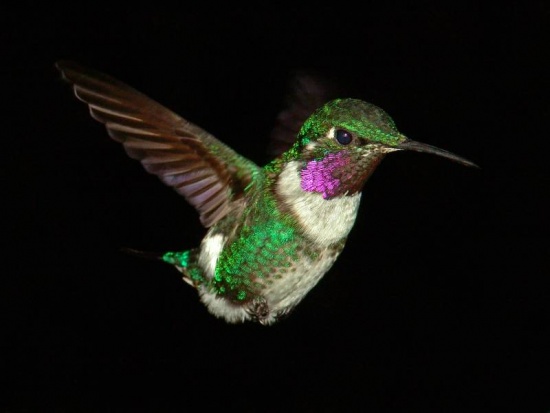m |
(Picture of juvenile. Some deleted text replaced. All sections now started. References. Incomplete gone) |
||
| Line 1: | Line 1: | ||
| − | + | [[Image:White-bellied_Woodstar_by_ejaramillo.jpg|thumb|550px|right|Male<br />Photo by {{user|ejaramillo|ejaramillo}} <br />Cuenca, [[Ecuador]]]] | |
| − | [[Image:White-bellied_Woodstar_by_ejaramillo.jpg|thumb|550px|right| | ||
;[[:Category:Chaetocercus|Chaetocercus]] mulsanti | ;[[:Category:Chaetocercus|Chaetocercus]] mulsanti | ||
''Acestrura mulsant'' | ''Acestrura mulsant'' | ||
==Identification== | ==Identification== | ||
| − | + | 8·5 cm (3¼-3½ in)<br /> | |
| + | '''Male''' | ||
| + | *Bluish-green upperparts and flanks | ||
| + | *White breast | ||
| + | *Lilac throat | ||
| + | *White post-ocular spot continues with a line to join breast | ||
| + | [[Image:White-bellied_Woodstar_mmdnje.jpg|thumb|275px|right|Female<br />Photo by {{user|mmdnje|mmdnje}} <br />Tandayapa Lodge, [[Ecuador]], December 2007]] | ||
==Distribution== | ==Distribution== | ||
| − | [[ | + | [[South America]]: found in [[Colombia]], [[Ecuador]], [[Peru]] and [[Bolivia]] |
==Taxonomy== | ==Taxonomy== | ||
| − | This is a monotypic species. This and other species have previously been placed in genus ''[[:Category:Acestrura|Acestrura]]'' which is generally not currently recognized as valid. | + | This is a [[Dictionary_M-S#M|monotypic]] species<sup>[[#References|[1]]]</sup>. |
| + | |||
| + | This and other species have previously been placed in genus ''[[:Category:Acestrura|Acestrura]]'' which is generally not currently recognized as valid. | ||
==Habitat== | ==Habitat== | ||
| − | + | Edges of humid forest, highland pastures, and cultivated areas, riparian vegetation. At heights around | |
| − | |||
==Behaviour== | ==Behaviour== | ||
| − | + | ====Diet==== | |
| + | [[Image:White-bellied Woodstar juvenile male Guango Lodge.jpg|thumb|275px|rightJuvenile<br />Photo by {{user|Stanley+Jones|Stanley Jones}}<br />Guango Lodge, Papallacta, Napo Province, [[Ecuador]], January 2016]] | ||
| + | Not a lot is known about their diet, but they have been observed feeding on the nectar of flowering agave and other small flowers. | ||
==References== | ==References== | ||
| − | # | + | #{{Ref-Clements6thAug16}}#Avibase |
| + | #Handbook of the Birds of the World Alive (retrieved August 2016) | ||
{{ref}} | {{ref}} | ||
==External Links== | ==External Links== | ||
Revision as of 23:10, 23 August 2016
- Chaetocercus mulsanti
Acestrura mulsant
Identification
8·5 cm (3¼-3½ in)
Male
- Bluish-green upperparts and flanks
- White breast
- Lilac throat
- White post-ocular spot continues with a line to join breast
Distribution
South America: found in Colombia, Ecuador, Peru and Bolivia
Taxonomy
This is a monotypic species[1].
This and other species have previously been placed in genus Acestrura which is generally not currently recognized as valid.
Habitat
Edges of humid forest, highland pastures, and cultivated areas, riparian vegetation. At heights around
Behaviour
Diet
Not a lot is known about their diet, but they have been observed feeding on the nectar of flowering agave and other small flowers.
References
- Clements, J. F., T. S. Schulenberg, M. J. Iliff, D. Roberson, T. A. Fredericks, B. L. Sullivan, and C. L. Wood. 2016. The eBird/Clements checklist of birds of the world: v2016, with updates to August 2016. Downloaded from http://www.birds.cornell.edu/clementschecklist/download/
- Avibase
- Handbook of the Birds of the World Alive (retrieved August 2016)
Recommended Citation
- BirdForum Opus contributors. (2024) White-bellied Woodstar. In: BirdForum, the forum for wild birds and birding. Retrieved 9 May 2024 from https://www.birdforum.net/opus/White-bellied_Woodstar






